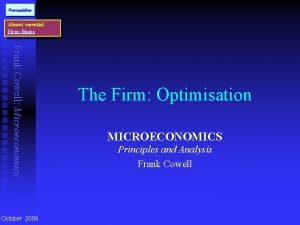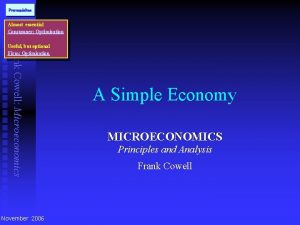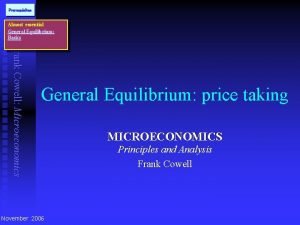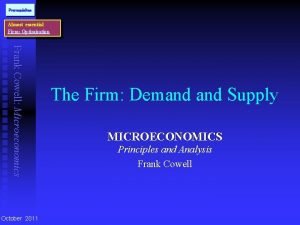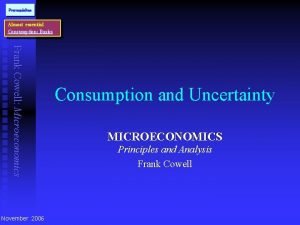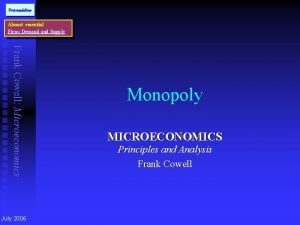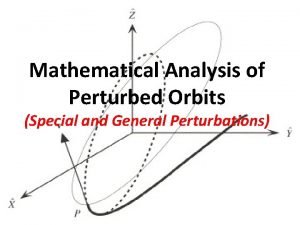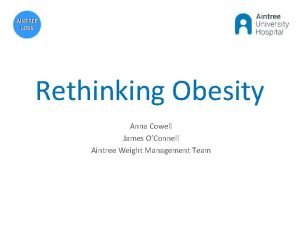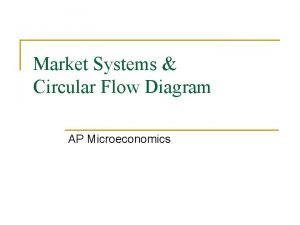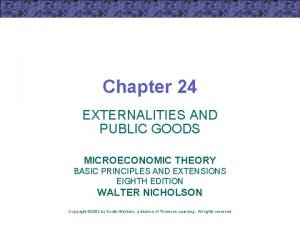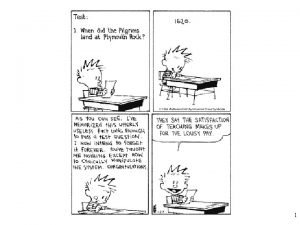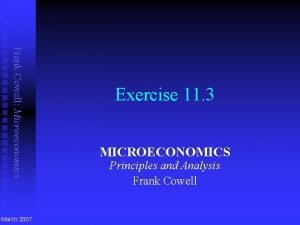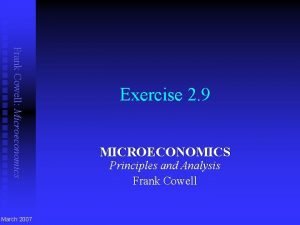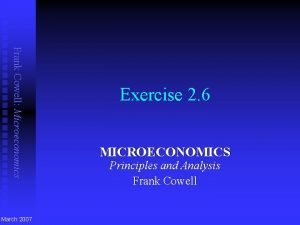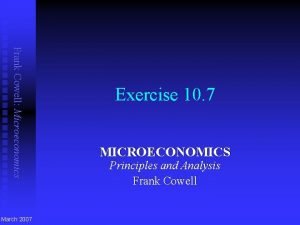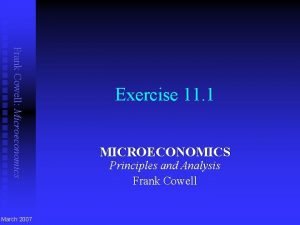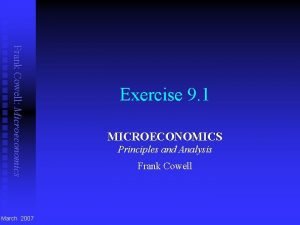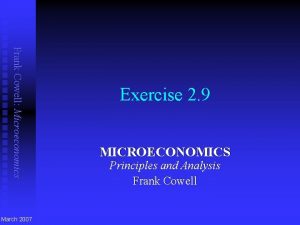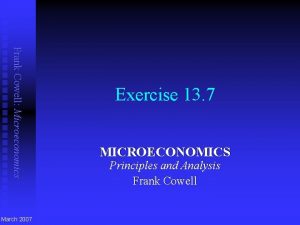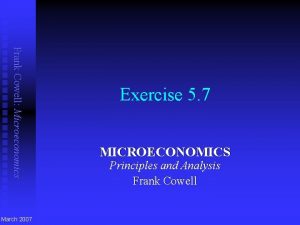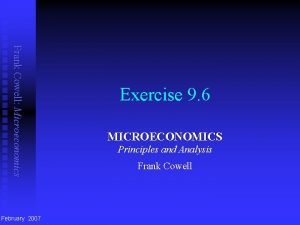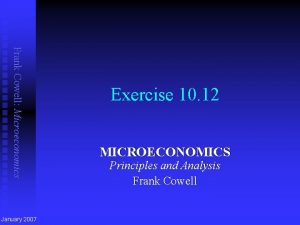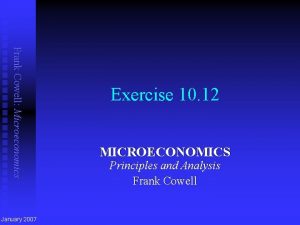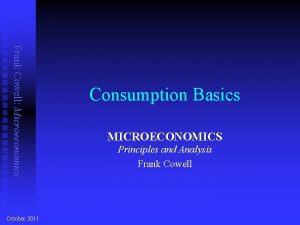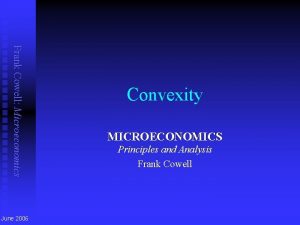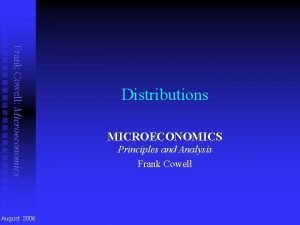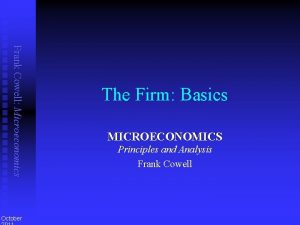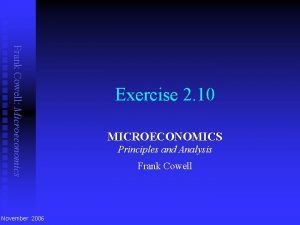Frank Cowell Microeconomics March 2007 Exercise 11 1




















- Slides: 20

Frank Cowell: Microeconomics March 2007 Exercise 11. 1 MICROECONOMICS Principles and Analysis Frank Cowell

Ex 11. 1(1): Question Frank Cowell: Microeconomics n n purpose: to illustrate and solve the “hidden information” problem method: find full information solution, describe incentive-compatibility problem, then find second-best solution

Ex 11. 1(1): Budget constraint Frank Cowell: Microeconomics n Consumer has income y and faces two possibilities u u n Define a binary variable i: u u n “not buy”: all y spent on other goods “buy”: y F(q) spent on other goods i = 0 represents the case “not buy” i = 1 represents the case “buy” Then the budget constraint can be written u x + i. F(q) ≤ y

Ex 11. 1(2): Question Frank Cowell: Microeconomics method: n First draw ICs in space of quality and other goods n Then redraw in space of quality and fee n Introduce iso-profit curves n Full-information solutions from tangencies

Ex 11. 1(2): Preferences: quality Frank Cowell: Microeconomics §(quality, other-goods) space F x §high-taste type §low-taste type §redraw in (quality, fee) space ta tb tb ta pre fer en ce §IC must be linear in t §t a > t b §Because linear ICs can only intersect once quality q

Ex 11. 1(2): Isoprofit curves, quality Frank Cowell: Microeconomics §(quality, fee) space F §Iso-profit curve: low profits §lso-profit curve: medium profits inc pro reas fit ing §lso-profit curve: high profits P 2 = F 2 C(q) §Increasing, convex in quality P 1 = F 1 C(q) P 0 = F 0 C(q) quality q

Ex 11. 1(2): Full-information Frank Cowell: Microeconomics solution §reservation IC, high type F §Firm’s feasible set for a high type §Reservation IC + feasible set, low type §lso-profit curves taq §Full-information solution, high type • F*a F*b §Full-information solution, low type tbq §Type-a participation constraint taqa Fa ≥ 0 • q*b §Type-b participation constraint tbqb Fb ≥ 0 q*a quality q §Full information so firm can put each type on reservation IC

Ex 11. 1(3, 4): Question Frank Cowell: Microeconomics method: n Set out nature of the problem n Describe in full the constraints n Show which constraints are redundant n Solve the second-best problem

Ex 11. 1(3, 4): Misrepresentation? Frank Cowell: Microeconomics §Feasible set, high type F §Feasible set, low type §Full-information solution taq §Type-a consumer with a type-b deal pre fer e F*a F*b nc e • §Type-a participation constraint taqa Fa ≥ 0 tbq §Type-b participation constraint tbqb Fb ≥ 0 • q*b q*a quality q §A high type-consumer would strictly prefer the contract offered to a low type

Ex 11. 1(3, 4): background to problem Frank Cowell: Microeconomics n Utility obtained by each type in full-information solution is y u u n If a-type person could get a b-type contract u u n n each person is on reservation utility level given the U function, if you don’t consume the good you get exactly y a-type’s utility would then be taq*b F*b +y given that tbq*b F*b = 0… …a-type’s utility would be [ta tb]q*b + y >y So an a-type person would want to take a b-type contract In deriving second-best contracts take account of 1. 2. participation constraints this incentive-compatibility problem

Ex 11. 1(3, 4): second-best problem Frank Cowell: Microeconomics n n Participation constraint for the two types u ta qa Fa ≥ 0 u tb qb Fb ≥ 0 Incentive compatibility requires that, for the two types: u taqa Fa ≥ taqb Fb u tb qb Fb ≥ tb qa Fa Suppose there is a proportion p, 1 p of a-types and b-types Firm's problem is to choose qa, qb, Fa and Fb to max expected profits u p[Fa C(qa)] + [1 p][Fb C(qb)] subject to u u n the participation constraints the incentive-compatibility constraints However, we can simplify the problem u u which constraints are slack? which are binding?

Ex 11. 1(3, 4): participation, b-types Frank Cowell: Microeconomics n First, we must have taqa Fa ≥ tbqb Fb u 1. 2. n This implies the following: u u n if tbqb Fb > 0 (b-type participation slack) then also taqa Fa > 0 (a-type participation slack) But these two things cannot be true at the optimum u u n this is because taqa Fa ≥ taqb Fb (a-type incentive compatibility) and ta > tb (a-type has higher taste than b-type) if so it would be possible for firm to increase both Fa and Fb thus could increase profits So b-type participation constraint must be binding u tbqb Fb = 0

Ex 11. 1(3, 4): participation, a-types Frank Cowell: Microeconomics n If Fb > 0 at the optimum, then qb > 0 u u n This implies taqb Fb > 0 u u n because a-type has higher taste than b-type ta > tb This in turn implies taqa Fa > 0 u u n follows from binding b-type participation constraint tbqb Fb = 0 follows from a-type incentive-compatibility constraint taqa Fa ≥ taqb Fb So a-type participation constraint is slack and can be ignored

Frank Cowell: Microeconomics Ex 11. 1(3, 4): incentive compatibility, a-types n Could a-type incentive-compatibility constraint be slack? u n If so then it would be possible to increase Fa … u u u n could we have taqa Fa > taqb Fb ? …without violating the constraint this follows because a-type participation constraint is slack taqa Fa > 0 So a-type incentive-compatibility must be binding u taqa Fa = taqb Fb

Frank Cowell: Microeconomics Ex 11. 1(3, 4): incentive compatibility, b-types n n Could b-type incentive-compatibility constraint be binding? u tbqa Fa = tbqb Fb ? If so, then qa = qb u u n So, both incentive-compatibility conditions bind only with “pooling” u u n follows from fact that a-type incentive-compatibility constraint is binding ta qa Fa = ta qb Fb which, with the above, would imply [tb ta]qa = [tb ta]qb given that ta > tb this can only be true if qa = qb but firm can do better than pooling solution: increase profits by forcing high types to reveal themselves So the b-type incentive-compatibility constraint must be slack u tbqb Fb > taqb Fb u …and it can be ignored

Ex 11. 1(3, 4): Lagrangean Frank Cowell: Microeconomics n Firm's problem is therefore u u u n max expected profits subject to. . …binding participation constraint of b type …binding incentive-compatibility constraint of a type Formally, choose qa, qb, Fa and Fb to max p[Fa C(qa )] + [1 p][Fb C(qb )] + l[tbqb Fb] + m[taqa Fa taqb +Fb] n Lagrange multipliers are u u l for the b-type participation constraint m for the a-type incentive compatibility constraint

Ex 11. 1(3, 4): FOCs Frank Cowell: Microeconomics n Differentiate Lagrangean with respect to Fa and set result to zero: u u n Differentiate Lagrangean with respect to qa and set result to zero: u u n p m=0 which implies m = p p. Cq(qa) + mta = 0 given the value of m this implies Cq(qa) = ta But this condition means, for the high-value a types: u u marginal cost of quality = marginal value of quality the “no-distortion-at-the-top” principle

Ex 11. 1(3, 4): FOCs (more) Frank Cowell: Microeconomics n Differentiate Lagrangean with respect to Fa and set result to zero: u u n Differentiate Lagrangean with respect to qb and set result to zero: u u u n 1 p l+m=0 given the value of m this implies l = 1 [1 p]Cq(qb) + ltb mta = 0 given the values of l and m this implies Cq (qa ) = ta [1 p]Cq(qb) + tb pta = 0 Rearranging we find for the low-value b-types u marginal cost of quality < marginal value of quality

Ex 11. 1(3, 4): Second-best solution Frank Cowell: Microeconomics §Feasible set for each type F §Iso-profit contours §Contract for low type taq §Contract for high type pre fer Fa Fb en ce • §Low type is on reservation IC, but MRS≠MRT tbq §High type is on IC above reservation level, but MRS=MRT • qb q*a quality q

Ex 11. 1: Points to remember Frank Cowell: Microeconomics n n n Full-information solution is bound to be exploitative Be careful to specify which constraints are important in the second-best Interpret the FOCs carefully
 The firm basics
The firm basics Cowell microeconomics
Cowell microeconomics Almost essential
Almost essential Cowell microeconomics
Cowell microeconomics Cowell microeconomics
Cowell microeconomics Cowell microeconomics
Cowell microeconomics Cowell microeconomics
Cowell microeconomics Almost essential
Almost essential Frank cowell
Frank cowell Frank cowell
Frank cowell Poland national anthem lyrics
Poland national anthem lyrics Encke's method
Encke's method Cowell china
Cowell china Agilent erp
Agilent erp Anna cowell
Anna cowell Frank william abagnale jr. young
Frank william abagnale jr. young Circulair flow marketing
Circulair flow marketing Pure public good
Pure public good Example microeconomics
Example microeconomics Ap microeconomics unit 1 basic economic concepts
Ap microeconomics unit 1 basic economic concepts System of national accounting
System of national accounting
